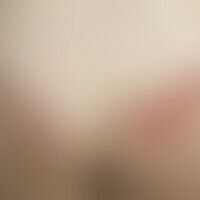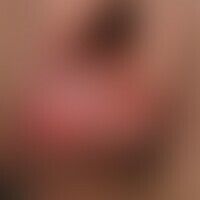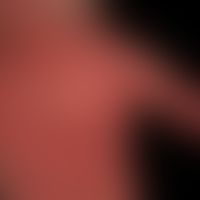Image diagnoses for "Plaque (raised surface > 1cm)"
570 results with 2865 images
Results forPlaque (raised surface > 1cm)

Lupus erythematosus subacute-cutaneous L93.1
Lupus erythematosus, subacute-cutaneous. Within a few months developing, light-emphasized exanthema with multi-forms and large plaques. No feeling of illness. High titre SSA-Ac.

Contact dermatitis toxic L24.-
contact dermatitis toxic: 41-year-old female patient who noticed these painful striated red plaques after accidental contact with a corrosive fluid. the configuration of the efflorescences is evidence of an exogenous mechanism. the "unphysiological" stripe pattern completely excludes endogenous triggering.

Psoriasis (Übersicht) L40.-
Psoriais pustulosa generalisata: pustular exanthema that develops within a few weeks in patients with known psoriasis; the figure shows a state already in the process of healing with a racy flake detachment

Seborrheic dermatitis of adults L21.9
dermatitis, seborrhoeic: 58-year-old patient with negative self- and family history of psoriasis. recurrent HV in the seboohoeic zones of the trunk for years. no itching. improvement in summer. multiple, chronically inpatient, figured, borderline, temporarily itching, moderately scaly, clearly borderline hardly elevated plaques.

Nummular dermatitis L30.0
Nummular Dermatitis: General view: For about 6-7 years persistent, strongly itching, solitary or confluent, coin-sized, infiltrated papules and plaques on the back of a 75-year-old female patient; in some cases small, dot-shaped, white, disseminated, atrophic scars are visible.

Nevus verrucosus Q82.5
Naevus verrucosus (detailed picture) striped arrangement of yellow-brownish papules and plaques.

Hypertrophic Lichen planus L43.81
Lichen planus verrucosus. 1 year old, constantly itchy, blurred, firm plaque with a wart-like surface structure. The clinical findings are to be distinguished from those of a Lichen simplex chronicus (Vidal ).

Balanitis plasmacellularis N48.1
Balanoposthitis plasmacellularis. 2 years (!) of varying degrees of persistent, burning and itching, sharply limited redness and erosions of the glans penis and prepuce in a 60-year-old patient, following preputial adhesions and frenuloplasty.

Toxic epidermal necrolysis L51.2
Toxic epidermal necrolysis: extensive, painful reddening of the palm with blistering.

Contagious impetigo L01.0

Atopic dermatitis (overview) L20.-
Eczema atopic (partial section of a generlised eczema): severe intrinsic atopic eczema that has been present for months; massive constant itching, intensified after sweating; numerous scratch marks.

Urticaria vasculitis M31.8
Urticarial vasculitis. 33-year-old female patient with distinct reduction of the az. 3 weeks of recurrent febrile attacks (CRP and SPA massively increased) and a distinct feeling of illness accompanied by a maculo-papular, moderately itchy exanthema. Histological: Evidence of a leukocytoclastic "small vessel vasculitis". The clinical differentiation from urticaria is possible by marking a persistent efflorescence for several days (marking test). Recurrent and changing arthritis.

Infant haemangioma (overview) D18.01

Lichen sclerosus (overview) L90.4

Verruca plantaris B07
verrucae plantares. sole of the foot in a 13-year-old competitive swimmer. painfulness during walking. lesions increasing since about 3 years. findings: aggregation, numerous, up to 2-4 mm large, clearly indurated horn crater with a slightly raised lateral horn wall (see left part of the picture). rough surface with whitish scaling. in some lesions approximately pinhead-sized, dark spot hemorrhages; see left part of the picture below.

Naevus melanocytic common D22.-
Common melanocytic nevus:Symmetrically structured melanocytic compound nevus of junctional and dermal cell nests with basal maturation coveredby papillomatous squamousepithelium. The nests are superficially discontinuously pigmented, accompanied by melanophages. The squamous epithelium is narrowed and with elongated reticules, covered by lamellar hyperkeratosis.
Extension along the hair follicles in strands, here partly neuroid cytomorphology of melanocytes.








